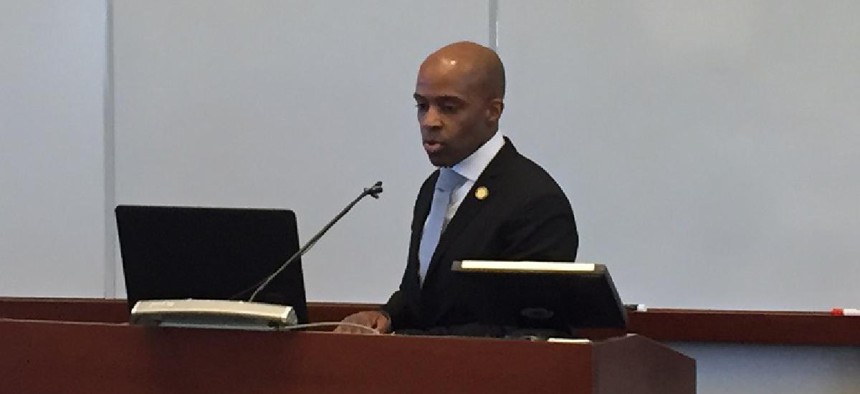After a one-year dip, Gov. Andrew Cuomo’s efforts to boost state contracting with businesses owned by minorities and women is again headed in the right direction.
Slightly more than 25 percent of all state contract dollars went to minority and women-owned business enterprises, or MWBEs, according to a recent report from Empire State Development. The new mark of 25.10 percent is above last year’s 23.23 percent rate and just shy of a record-setting 25.12 percent share in 2014.
Alphonso David, the counsel to the governor, said the state had continued the strategies that have worked in the past in an effort to raise the bar on participation for MWBE businesses.
“I think we are engaging more MWBE’s in industries that they have not historically operated in, which is why I think you’re seeing some changes in the program,” David said. “There’s more engagement from MWBE’s that we would not have seen six years ago.”
Before last year’s dip – the figures for 2015 fell by nearly 2 percentage points – the Cuomo administration had been on a consistent upward trajectory, bringing participation from 10 percent to 25 percent in just five years. On the heels of that successful track record, Cuomo bet he could continue to do better, setting a goal of 30 percent at the annual MWBE conference in 2014.
David said he couldn’t point to any particular factor to account for last year’s drop, but said he is confident that the state will reach its 30 percent goal.
One way to do that will be to identify industries where there is lower participation numbers for MWBE businesses, and engage people from that community about the opportunities they may be missing out on, he said.
“We will continue to actively engage with minority and women owned-businesses statewide,” David said. “We will look at specific industries MWBE’s have not historically operated in to see how we might be able to engage them in those industries.”
Still, the administration has yet to come close to hitting its ambitious 30 percent participation goal as several large state agencies have struggled to increase MWBE contracting. For example, the state Department of Environmental Conservation only allocated 8.9 percent for its $143 million in contracts to MWBEs, a steep decline after hitting 32 percent in 2015. The year before, 59 percent of the agency’s contracts went to such companies.
Katherine Lemire, a former prosecutor who now does consulting work on MWBE compliance and an owner of a certified woman-owned business, said that the Cuomo’s administration’s goal of 30 percent MWBE participation is “admirable,” but that there are still significant challenges to getting there.
In particular, by making the goal statewide, the administration has to drive participation in regions where there simply are not as many minority- and women-owned businesses.
“Especially when you go upstate, it’s harder to find MWBEs,” Lemire said. “They’re just clustered more around NYC.”
Lemire said she could not see any clear reason for last year’s drop. Stressing that she was speculating, she added that it may have to do with increased scrutiny, including Manhattan District Attorney Cyrus Vance’s report on MWBE fraud from 2014.
However, Lemire said she has seen more and more companies applying to be certified as an MWBE. At this year’s state conference on MWBEs, that growth was evidenced in the number of people who attended and an increase in the number of people asking about her services.
Another hurdle to getting more MWBEs certified is the application process itself. While the state has taken steps to make its process easier, some municipalities have more complicated processes.
Rev. Jacques DeGraff, who has long fought to bring more public contracts to MWBEs, said that while he finds the overall numbers encouraging, he is concerned about the performance of some of the state’s largest agencies.
Of the 16 state agencies that spent $100 million or more last year, only the state Department of Health, Empire State Development and a SUNY fund exceeded the 30 percent mark, with a few more, including the state Gaming Commission and the Long Island Power Authority, coming within a few percentage points of the administration’s stated goal.
“The state has come a mighty long way under this administration,” DeGraff said. “But I think they would agree that there are legitimate concerns that need to be addressed.”
DeGraff praised Cuomo and his staff, noting that the numbers were around 10 percent when the governor took office. However, he believes that creating a single position with the sole responsibility of meeting the governor’s goals would go a long way toward making them a reality.
DeGraff praised Cuomo and his staff, noting that the numbers were around 10 percent when the governor took office. However, he believes that creating a single position with the sole responsibility of watching over and promoting the use of MWBE companies on upcoming “megaprojects” – LaGuardia, the Javits Convention Center – would go a long way toward reaching the governor’s goals.
“I think Alphonso David has been doing an outstanding job under difficult circumstances, and needs to be commended,” DeGraff said. “But I think we need an opportunity czar who concentrates on these projects full time.”
“The good news is there’s a lot to build on,” he added. “If you’re trying to get from 25 to 30 percent, it’s a lot different than trying to get from 9 to 30 percent.”


